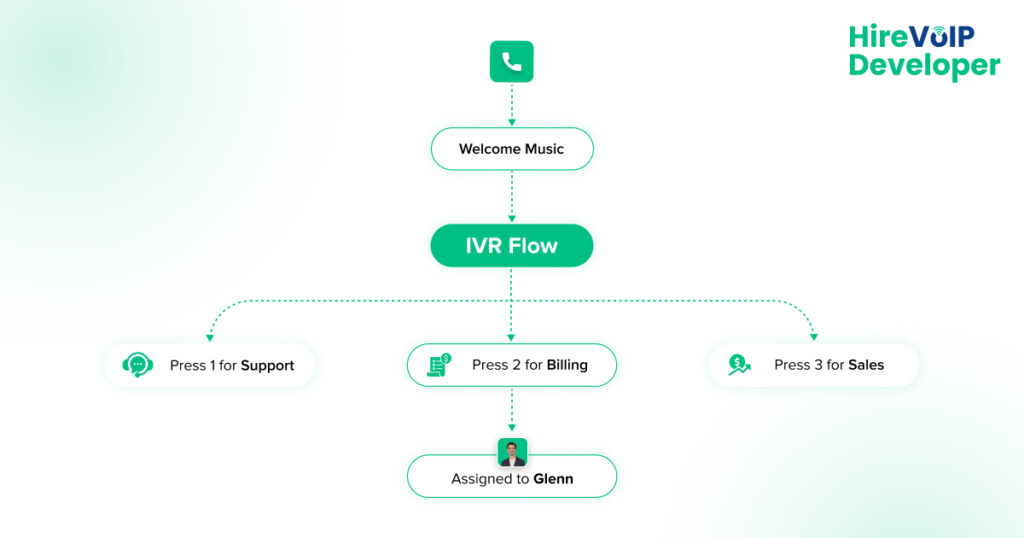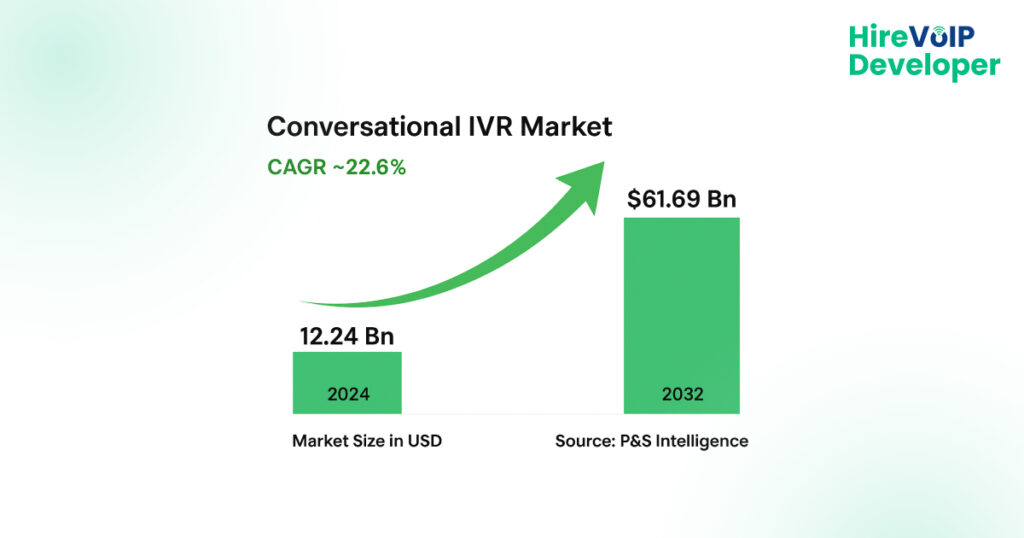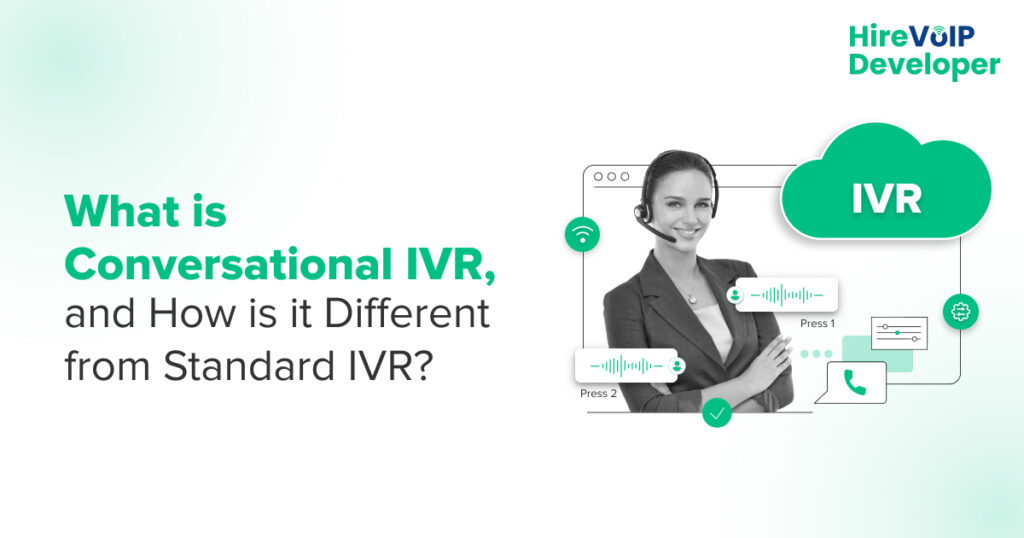🗝️ Key Highlights
-
- ✅ Conversational IVR transforms customer interactions by replacing rigid “press-a-number” menus with AI-powered, natural language conversations, making service faster, smoother, and more human-like.
-
- ✅ Market research and industry trends reveal a clear shift toward conversational IVR, with businesses adopting it to reduce call abandonment, improve CSAT scores, and gain a competitive edge in customer experience.
-
- ✅ The future of IVR lies in conversational AI, where continuous learning, contextual understanding, and seamless integration with digital channels position conversational IVR as the new industry standard.
Did you know that 67% of customers hang up the phone when faced with complicated IVR menus?
That’s two-thirds of potential opportunities lost, not because the business lacked solutions, but because the caller got trapped in endless “Press 1, Press 2” loops. Traditional IVRs, once hailed as efficient call-routing tools, are now one of the biggest sources of frustration in customer service. Customers today expect instant, human-like interactions, and clunky menu trees just don’t cut it anymore.
This growing dissatisfaction has sparked a major shift in the contact center landscape: the rise of conversational IVR, also known as customized IVR solutions. Powered by AI and natural language processing, it’s transforming customer interactions from robotic to human-like. However, before we delve into this modern approach, let’s first examine what traditional IVR is and why it’s losing relevance.
What is Standard IVR?
Standard IVR, or Interactive Voice Response, is the legacy system most of us have encountered. It works on DTMF (Dual-Tone Multi-Frequency) signaling, meaning you interact by pressing keypad options to navigate menus.
On paper, this system has several advantages:
✅ It’s cost-effective.
✅ Available 24/7.
✅ Reduces agent workload by routing calls efficiently.
However, in practice, these benefits often give way to limitations. Long, confusing menu trees test customers’ patience, and one wrong selection means starting over from the beginning. Unsurprisingly, this results in higher abandonment rates and lower customer satisfaction. For today’s digital-first customers, standard IVR feels more like a barrier than a solution.
That’s why businesses are moving away from this legacy model and exploring more advanced alternatives.
Which brings us to conversational IVR.
For foundational insights into IVR evolution and why design matters, check out our detailed guide on IVR design best practices and deployment strategies.
What is Conversational IVR?
Unlike rigid menu-based IVRs, conversational IVR leverage AI and NLP (Natural Language Processing) to understand what callers say in their own words. Instead of pressing buttons, customers can simply state their intent, “I want to check my balance”, and the system responds accordingly.

💭 Myth
Conversational IVR is just a fancier version of standard IVR.
✅ Reality
It’s powered by AI and NLP, making it capable of understanding natural speech, intent, and emotions, something standard IVR can’t do.
Here’s how it works:
- Speech Recognition captures the customer’s voice.
- Intent Detection processes the meaning behind the words.
- Contextual Routing directs the caller to the right service or solution.
Research backs this up. Academic studies highlight that conversational IVR reduces average handle times while improving CSAT (Customer Satisfaction) scores. Customers feel heard, rather than being forced to fit into rigid categories.
Real-world use cases are everywhere:
✅ Banking: balance checks, fraud alerts.
✅ Telecom: plan upgrades, troubleshooting.
✅ Airlines: flight status, check-ins.
✅ Healthcare: appointment scheduling, prescription refills.
So, if you’re wondering: “How much better is the customer experience with conversational IVR compared to standard IVR?”, the answer is significantly better, both in speed and satisfaction.
Don’t let robotic menus drive customers away. Make them feel heard.
5 Key Differences Between Conversational IVR vs Standard IVR
When it comes to customer interactions, the difference between standard IVR and conversational IVR is like comparing a rotary phone with a modern smartphone; both serve the same basic purpose, but one is rigid and outdated, while the other is intelligent, flexible, and built for today’s needs. Traditional IVR was designed decades ago to reduce agent workload and automate simple tasks through keypad-based navigation. It worked well when expectations were lower, but in the era of instant gratification, it often feels like a barrier rather than a bridge.
Conversational IVR, on the other hand, represents the future. By leveraging AI, Natural Language Processing (NLP), and speech recognition, it transforms the caller’s journey into a seamless, human-like conversation. Instead of forcing customers through repetitive, robotic menus, it adapts to their intent from the very first statement. This distinction goes beyond convenience; it fundamentally reshapes how customers perceive your brand, how efficiently queries are resolved, and how well your support system scales with growth.
For deeper insights on IVR design best practices for Businesses, explore our dedicated guide on designing customer-friendly IVR systems.
And, let’s explore the five biggest differences in detail:
1. Interaction Style
Standard IVR: Interaction is rigid and menu-driven. Customers are given a set of numbered options, “Press 1 for Sales, Press 2 for Support”, and must adapt their needs to the menu. If their issue doesn’t fit neatly, they’re stuck. The system dictates the flow of interaction, often making callers feel powerless.
Conversational IVR: Interaction is free-flowing and intent-based. Callers simply state their needs in natural language, like “I need to reset my password” or “Book me on the earliest available flight.” The system listens, understands, and responds intelligently. Here, the customer drives the conversation, creating a sense of control and empowerment.
2. Customer Experience
Standard IVR: For many customers, traditional IVRs are a source of frustration. Long menus, repeated prompts, and the possibility of choosing the wrong option make the process slow and impersonal. In fact, studies show that long menu trees are a leading cause of call abandonment rates, which sometimes exceed 60%. This damages both customer trust and brand reputation.
Conversational IVR: Conversational IVR flips the script by making interactions intuitive and effortless. Customers don’t need to remember menus or worry about pressing the wrong number. The system understands intent and guides them quickly to the right answer or agent. By eliminating barriers, conversational IVR creates a smoother, more human-like experience, which translates directly into higher satisfaction scores and stronger customer loyalty.
3. Technology Stack
Standard IVR: Traditional systems are built on DTMF (Dual-Tone Multi-Frequency) signaling, which processes keypad inputs. While reliable, this technology is decades old and hasn’t evolved to meet the demands of conversational, customer-centric interactions. It can’t interpret spoken queries, recognize context, or adapt to complex needs; it’s essentially a static system.
Conversational IVR: Powered by AI, NLP, and advanced speech recognition, conversational IVR doesn’t just capture words, it interprets meaning, context, and even sentiment. Modern systems can recognize accents, handle multiple languages, and continuously learn from interactions to become more accurate over time. This makes conversational IVR not just smarter but also far more scalable and inclusive.
4. Resolution Time
Standard IVR: Resolution times are often longer because callers must navigate multiple menu layers before reaching the correct option. Even then, misroutes are common, forcing them to repeat the process or wait for a live agent. For simple tasks like balance checks or password resets, this process feels unnecessarily drawn out, leading to frustration.
Conversational IVR: By detecting intent right at the start of the conversation, conversational IVR reduces resolution times dramatically. Customers are routed directly to the solution or provided an instant automated response. Simple tasks are completed in seconds, while more complex issues are quickly escalated to the right agent with full context. This not only saves customers’ time but also reduces operational costs for businesses.
5. Market Sentiment
Standard IVR: Over the years, customer sentiment toward standard IVRs has declined. Many customers associate IVRs with wasted time and robotic, impersonal service. In fact, surveys reveal that a significant percentage of customers dread interacting with IVRs and see them as outdated. Businesses that rely solely on traditional IVRs risk alienating modern, digital-savvy consumers.
Conversational IVR: Market sentiment around conversational IVR is far more positive. Customers appreciate being able to “just explain their issue” rather than memorizing options. Businesses adopting conversational IVR solutions report higher CSAT (Customer Satisfaction) and NPS (Net Promoter Scores), with fewer abandoned calls. For many organizations, conversational IVR isn’t just a technology upgrade, it’s a brand differentiator, signaling innovation, empathy, and customer-first thinking.
Poll:
👉What stops you from moving to Conversational IVR today?
✅ Thanks for voting!
By now, the differences are crystal clear: while standard IVR locks customers into rigid pathways, conversational IVR empowers them with freedom and speed.
But beyond this side-by-side comparison, what do real-world adoption rates and customer feedback reveal?
Let’s dive into the market sentiments and trends that are shaping the future of IVR.
Market Sentiments and Trends in Conversational IVR
The customer service landscape is undergoing a massive transformation, and IVR systems are at the center of it. Traditional IVRs once served as cost-saving tools, but over time, they became synonymous with long menus, robotic voices, and frustrating loops. Customers today expect faster, more personalized service, something that outdated systems fail to provide. This dissatisfaction has fueled the rise of conversational IVR solutions, and market sentiment clearly shows a shift toward AI-powered alternatives.
Growing Adoption Backed by Data
The conversational IVR market was valued at USD 12.24 billion in 2024, growing to USD 61.69 billion by 2032 (CAGR ~22.6%), with IVR forming one of the most crucial applications of this technology. In fact, a 2024 survey by Call Centre Helper revealed that nearly 70% of businesses are planning to upgrade their existing IVR systems to conversational AI within the next three years. Customers, too, are voicing this demand, over 61% say they prefer speaking naturally to a system rather than “pressing buttons” to navigate endless menus. These statistics highlight the undeniable momentum behind conversational IVR adoption.

Market Sentiment for Businesses and Customers
From the business perspective, conversational IVR is not seen as just another technology upgrade but as a competitive differentiator. Companies realize that better CX (customer experience) directly correlates with customer loyalty and revenue growth. Enterprises that have piloted conversational IVR report measurable improvements in CSAT scores and Net Promoter Scores (NPS).
On the customer side, sentiment is overwhelmingly positive, users feel heard, understood, and valued when interacting with an IVR that can actually “listen” and respond intelligently. Unlike traditional IVRs that often symbolize barriers, conversational IVRs are being perceived as bridges to better service.
5 Emerging Trends Shaping the Market
- Multilingual Support: With globalization, businesses cater to diverse customers across geographies. Conversational IVR now offers multilingual capabilities powered by advanced NLP, making it easier for brands to connect authentically with their audience in local languages and dialects.
- Omnichannel Integration: Customers no longer interact with businesses through a single channel. Conversational IVR is being integrated with chatbots, messaging apps, and CRM platforms, creating a unified omnichannel experience. For example, a query initiated on WhatsApp can seamlessly continue on a voice call, without losing context.
- Personalization at Scale: Unlike standard IVR, conversational IVR uses AI-driven contextual awareness to tailor responses. Imagine calling your bank and the system instantly recognizing your account history to provide faster, more relevant support. This kind of personalized interaction is fast becoming an expectation, not a luxury.
- Voice AI as a Differentiator: In saturated markets, customer experience is the ultimate battleground. Businesses are increasingly positioning voice AI-enabled conversational IVR as a key differentiator. It’s no longer about offering support, it’s about offering smart, empathetic, and human-like support that enhances brand image.
- Proactive IVR Systems: Emerging systems can now predict intent based on previous interactions, allowing businesses to proactively solve issues before customers even articulate them. This proactive trend is setting a new standard for what “intelligent customer service” means.
The overall sentiment is clear: traditional IVR has run its course, and conversational IVR is quickly becoming the new benchmark for customer engagement. Businesses that lag in this transition risk falling behind, while those embracing conversational IVR are positioning themselves as forward-thinking, customer-first brands.
Poll:
How do you feel about the ROI your current IVR system delivers for your business?
✅ Thanks for voting!
Technological Impact of Conversational IVR
The rise of conversational IVR is not just a trend, it’s a direct outcome of advancements in artificial intelligence and speech technologies. Traditional IVR systems relied heavily on DTMF (Dual-Tone Multi-Frequency) tones and pre-defined scripts, which limited flexibility. Conversational IVR, however, integrates a suite of modern technologies that redefine the way customers interact with businesses.
With AI-driven speech recognition and real-time NLP, businesses are now moving closer to human-like conversations in customer support. This shift is part of the broader rise of AI-powered VoIP call center solutions that deliver smarter automation, better accuracy, and more efficient workflows.
- Natural Language Processing (NLP) and Automatic Speech Recognition (ASR): NLP enables machines to understand context, accents, emotions, and intent. Combined with ASR, conversational IVR can handle a wide range of human expressions like “I lost my card,” “Cancel my subscription,” or “When is my next appointment?”—without forcing customers into rigid choices.
- Machine Learning and Adaptive AI Models: Conversational IVR systems continuously learn from customer interactions, improving their accuracy and efficiency over time. This adaptive nature reduces friction and ensures more personalized responses.
- Cloud-Based Scalability: Unlike on-premises IVRs, modern conversational IVRs leverage cloud infrastructure, making it easy for businesses to scale capacity during peak hours (e.g., holiday sales, emergencies) without costly hardware.
- Omnichannel Integration: These systems can sync with chatbots, SMS, mobile apps, and CRMs, creating a unified customer journey across voice and digital touchpoints.
💡Pro Tip:
Train your Conversational IVR with real customer transcripts to improve intent recognition accuracy.
In short, conversational IVR represents a technological leap forward, making customer service not only faster but smarter and more human-like.
Why Businesses Are Shifting Toward Conversational IVR
The shift toward conversational IVR is being fueled by a customer-first mindset. Today’s consumers expect quick resolutions, personalized interactions, and frictionless experiences. Standard IVRs often fall short in meeting these expectations, leading to frustration and high call abandonment rates.
-
- Improved Customer Satisfaction: Studies show that conversational IVR reduces call handling time and improves First Call Resolution (FCR). Customers prefer explaining their issues in their own words rather than navigating endless menus.
- Cost Optimization: Automating common queries (account balance checks, password resets, booking confirmations) reduces the need for live agents, allowing businesses to save up to 30–40% in operational costs.
💭 Myth
Conversational IVR is too expensive for mid-sized businesses.
✅ Reality
With cloud-based deployment and CPaaS models, even SMEs can adopt it cost-effectively.
- Scalability & Efficiency: Conversational IVRs handle large volumes of calls effortlessly, providing consistency even during peak demand.
- Brand Perception: A fluid, conversational experience signals that a company values customer time and invests in innovation. This directly strengthens brand loyalty.
Beyond improving customer satisfaction, companies also see strong ROI through automation, faster resolutions, and cost savings. To understand the wider benefits of integrating AI and ML with VoIP, you can explore how machine learning amplifies call routing, personalization, and analytics.
So as a result, enterprises across banking, telecom, retail, travel, and healthcare are rapidly adopting conversational IVR as a way to align with evolving customer expectations.
Challenges in Implementing Conversational IVR
Despite its clear advantages, conversational IVR implementation isn’t without hurdles. Businesses must navigate several complexities before fully reaping the benefits.
- High Initial Investment: Developing an AI-driven IVR requires advanced NLP models, integrations, and testing, which can be cost-prohibitive for smaller businesses.
- Complex System Integration: To be effective, conversational IVRs must integrate seamlessly with CRMs, ticketing tools, and knowledge bases. Legacy infrastructure often makes this integration challenging.
- Data Privacy & Compliance: Since conversational IVRs process sensitive customer data, ensuring compliance with GDPR, HIPAA, or PCI DSS is crucial. Mishandling data can lead to legal and reputational risks.
- Accuracy of AI Models: While NLP has advanced significantly, regional accents, background noise, and ambiguous phrases can still lead to misinterpretations, sometimes frustrating customers.
- Change Management: Businesses must retrain support staff and re-educate customers who are used to standard IVR systems. Transitioning requires time, patience, and user adoption strategies.
One of the toughest aspects is managing backend integrations across CRMs, ERPs, and other customer support systems. If not planned well, these hurdles can create downtime and customer dissatisfaction. A look at our resource on VoIP integration challenges and best practices provides actionable strategies to navigate such implementation roadblocks effectively.
In short, while the benefits are substantial, planning, integration, and training are critical to overcome these challenges.
Future of Conversational IVR and Road Ahead
The future of IVR lies in personalization, automation, and intelligence. Traditional IVR will not vanish overnight, but its role will shrink to basic, low-cost setups. Conversational IVR will become the default standard as customers increasingly favor human-like, intuitive interactions.
⏭️ Hyper-Personalized Experiences: Future systems will use customer history, preferences, and predictive analytics to tailor responses, for example, proactively suggesting solutions before customers even articulate their problem.
⏭️ Voice Biometrics: Authentication will shift from PINs and passwords to voice-based verification, enhancing both convenience and security.
⏭️ AI + Human Collaboration: Smart IVRs will work in tandem with human agents, handing over complex queries with full context, reducing customer repetition.
⏭️ Multilingual Support: As businesses expand globally, conversational IVRs will become more adept at handling multiple languages and dialects.
In the next 3–5 years, IVR systems will no longer be judged on their ability to “route calls” but on how effectively they can resolve customer queries autonomously while maintaining a natural, human-like tone.
⚡ Ditch the outdated menus—embrace AI-driven Conversational IVR
-
Wrapping Up
Standard IVR and conversational IVR are worlds apart. While one relies on rigid menu-driven navigation, the other offers fluid, AI-driven conversations that customers actually enjoy. The shift is not just about technology, it’s about creating customer-first experiences.
Here’s why conversational IVR is the smarter choice:
- Faster query resolution.
- Smarter, intent-driven interactions.
- Improved customer satisfaction with lower call abandonment.
So, the question isn’t “Can conversational IVR actually reduce frustration and call abandonment rates?” It’s “Why wouldn’t you make the switch?” Conversational IVR isn’t just a trend—it’s shaping the future of customer experience.
And if you’re wondering, “Can conversational IVR be integrated into our existing telephony system, PBX, or VoIP setup without a complete overhaul?”, the answer is yes, especially with expert help. That’s where Hire VoIP Developer steps in, ensuring seamless integration and tailored solutions for your business.
FAQs


